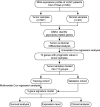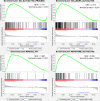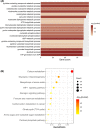Identification of a glycolysis-related gene signature associated with clinical outcome for patients with lung squamous cell carcinoma
- PMID: 33991070
- PMCID: PMC8209576
- DOI: 10.1002/cam4.3945
Identification of a glycolysis-related gene signature associated with clinical outcome for patients with lung squamous cell carcinoma
Abstract
Background: Lung squamous cell carcinoma (LUSC), one of the main types of lung cancer, has caused a huge social burden. There has been no significant progress in its therapy in recent years, Resulting in a poor prognosis. This study aims to develop a glycolysis-related gene signature to predict patients' survival with LUSC and explore new therapeutic targets.
Methods: We obtained the mRNA expression and clinical information of 550 patients with LUSC from the Cancer Genome Atlas (TCGA) database. Glycolysis genes were identified by Gene Set Enrichment Analysis (GSEA). The glycolysis-related gene signature was established using the Cox regression analysis.
Results: We developed five glycolysis-related genes signature (HKDC1, AGL, ALDH7A1, SLC16A3, and MIOX) to calculate each patient's risk score. According to the risk score, patients were divided into high- and low-risk groups and exhibited significant differences in overall survival (OS) between the two groups. The ROC curves showed that the AUC was 0.707 for the training cohort and 0.651 for the validation cohort. Additionally, the risk score was confirmed as an independent risk factor for LUSC patients by Cox regression analysis.
Conclusion: We built a gene signature to clarify the connection between glycolysis and LUSC. This model performs well in evaluating patients' survival with LUSC and provides new biomarkers for targeted therapy.
Keywords: gene signature; glycolysis; lung squamous cell carcinoma; survival.
© 2021 The Authors. Cancer Medicine published by John Wiley & Sons Ltd.
Conflict of interest statement
The authors have no conflict of interest to declare.
Figures










Similar articles
-
A glycolysis-based three-gene signature predicts survival in patients with lung squamous cell carcinoma.BMC Cancer. 2021 May 27;21(1):626. doi: 10.1186/s12885-021-08360-z. BMC Cancer. 2021. PMID: 34044809 Free PMC article.
-
Identification of a seven-miRNA signature as prognostic biomarker for lung squamous cell carcinoma.Oncotarget. 2016 Dec 6;7(49):81670-81679. doi: 10.18632/oncotarget.13164. Oncotarget. 2016. PMID: 27835574 Free PMC article.
-
Identification and validation of an individualized prognostic signature of lung squamous cell carcinoma based on ferroptosis-related genes.Thorac Cancer. 2021 Dec;12(23):3236-3247. doi: 10.1111/1759-7714.14195. Epub 2021 Oct 20. Thorac Cancer. 2021. PMID: 34672420 Free PMC article.
-
Identification of ALDH7A1 as a DNA-methylation-driven gene in lung squamous cell carcinoma.Ann Med. 2025 Dec;57(1):2442529. doi: 10.1080/07853890.2024.2442529. Epub 2024 Dec 23. Ann Med. 2025. PMID: 39711312 Free PMC article.
-
Squamous cell lung cancer: genomic evolution and personalized therapy.Salud Publica Mex. 2019 May-Jun;61(3):329-338. doi: 10.21149/10115. Salud Publica Mex. 2019. PMID: 31276347 Review. English.
Cited by
-
Development and Validation of a 7-Gene Inflammatory Signature Forecasts Prognosis and Diverse Immune Landscape in Lung Adenocarcinoma.Front Mol Biosci. 2022 Mar 15;9:822739. doi: 10.3389/fmolb.2022.822739. eCollection 2022. Front Mol Biosci. 2022. PMID: 35372503 Free PMC article.
-
Energy metabolism as the hub of advanced non-small cell lung cancer management: a comprehensive view in the framework of predictive, preventive, and personalized medicine.EPMA J. 2024 Apr 8;15(2):289-319. doi: 10.1007/s13167-024-00357-5. eCollection 2024 Jun. EPMA J. 2024. PMID: 38841622 Free PMC article. Review.
-
Comprehensive pan-cancer analysis identified SLC16A3 as a potential prognostic and diagnostic biomarker.Cancer Cell Int. 2025 Apr 29;25(1):168. doi: 10.1186/s12935-025-03791-1. Cancer Cell Int. 2025. PMID: 40301866 Free PMC article.
-
HKDC1 promotes liver cancer stemness under hypoxia through stabilizing β-catenin.Hepatology. 2025 Jun 1;81(6):1685-1699. doi: 10.1097/HEP.0000000000001085. Epub 2024 Sep 6. Hepatology. 2025. PMID: 39250463 Free PMC article.
-
Effects of Camrelizumab Combined with First-Line Chemotherapy on Serum SCC, VEGF Levels, and Adverse Reactions in Patients with Advanced Squamous Cell Carcinoma of the Lung.Comput Intell Neurosci. 2022 Nov 18;2022:3137370. doi: 10.1155/2022/3137370. eCollection 2022. Comput Intell Neurosci. 2022. Retraction in: Comput Intell Neurosci. 2023 Jul 19;2023:9879124. doi: 10.1155/2023/9879124. PMID: 36438688 Free PMC article. Retracted. Clinical Trial.
References
-
- Siegel RL, Miller KD, Jemal A. Cancer statistics, 2020. CA Cancer J Clin. 2020;70(1):7‐30. - PubMed
-
- Qi L, Gao C, Feng F, et al. MicroRNAs associated with lung squamous cell carcinoma: new prognostic biomarkers and therapeutic targets. J Cell Biochem. 2019;120(11):18956‐18966. - PubMed
-
- Xu Y, Li J, Wang P, Zhang Z, Wang X. LncRNA HULC promotes lung squamous cell carcinoma by regulating PTPRO via NF‐kappaB. J Cell Biochem. 2019;120(12):19415‐19421. - PubMed
MeSH terms
Substances
LinkOut - more resources
Full Text Sources
Other Literature Sources
Medical
Miscellaneous

